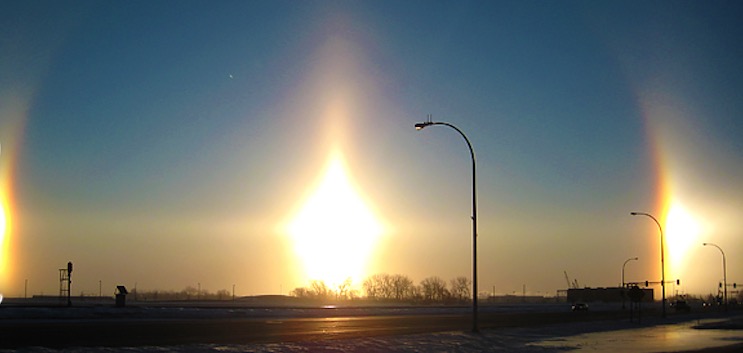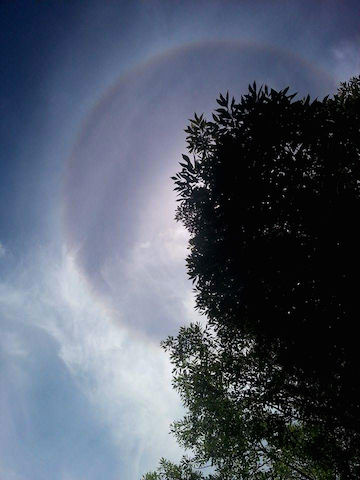Indbygger i St. George, Janna Fox var heldig nok at få øje på en solhalo i søndags fra hendes indkørsel omkring 900 South og River Road.
"Min 13 årige dreng så den først og kom ind og fortalte os det, fortalte Fox St. George News. "Jeg har aldrig før i mine 35 år set en solhalo! Det er virkeligt fedt!!"
Både solhaloer og bisole er forårsaget af sollys som passerer gennem iskrystaller i de høje tynde Cirrus skyer som ofte bevæger sig ind før et stormsystem. Sollyset reflekteres og bøjer, eller brydes og forårsager disse spektakulære syn.
Disse iskrystaller kan ses året rundt fordi den øverste atmosfære altid er under frysepunktet.
En ring eller cirkel af lys omkring solen eller månen kaldes en halo, eller for de mere videnskabeligt orienteret, en parhelisk cirkel eller ring.
Bisole er regnbuefarvede sprøjt som ofte er set til venstre eller til højre for solen. Bisole er også kendt som parhelion og er formet af pladeformede iskrystaller som driver i skyerne, ifølge NASA.com.
Kommentar: Vi undskylder at resten af artiklen ikke er oversat. Der henvises til disse artikler på dansk om de to fænomener. Solhalo og bisole.
Cirrus clouds are made of millions of hexagonal ice crystals 3 miles to 6 miles up in the atmosphere. Each ice crystal acts as a tiny prism bending the sun's light and throwing it elsewhere into the sky. The spectacular displays in the sky depend on the size and tilt of the ice crystals.
There's an old weather saying, "ring around the moon means rain soon," and there is truth to that, according to Earthsky.org. High thin cirrus clouds often precede a storm system, at 20,000 feet. These clouds contain ice crystals, by the millions. The halos are caused by both refraction and reflection of sunlight.
Sundogs and sun halos are just two of nearly four dozen different kinds of effects produced by sunlight interacting with ice crystals in the sky.
So when's the best way to catch one of these beauties in the sky? Both sun halos and sundogs may be seen whenever and wherever there are cirrus clouds in the sky.
The best displays are most commonly seen in the fall, winter and spring when the northern jet stream descends southward, drawing down Arctic air masses that carry ice crystals.
Sundogs are found at or more than 22 degrees to the left or right of the sun and at the same height above the horizon as the sun.
Because sundogs and sun halos are found near the sun, viewers should protect their eyes while viewing.





Kommentar: Vores himmel og atmosfære er under forandring og det skyldes sandsynligvis at vores atmosfære fyldes med kometstøv og altså ikke blot iskrystaller.
Se: